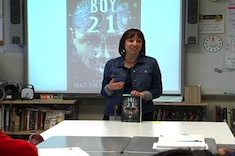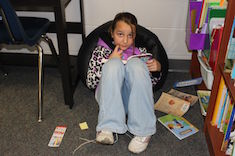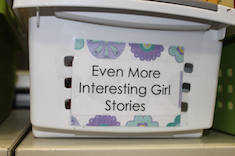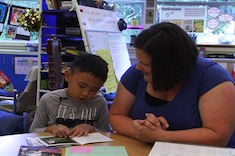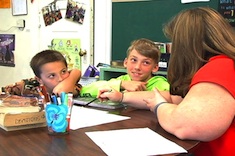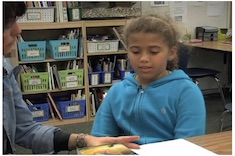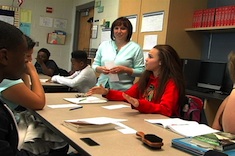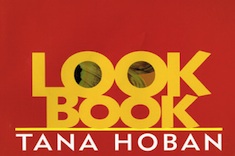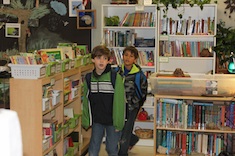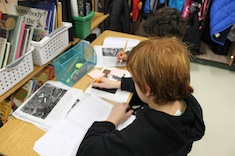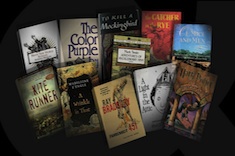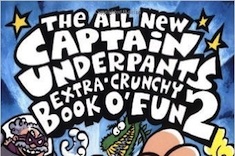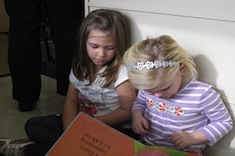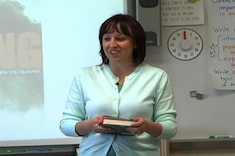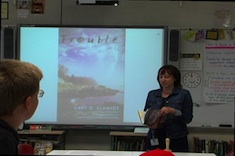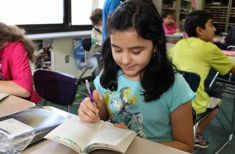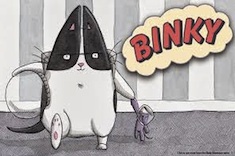Teaching Reading
Our contributors lead reading workshops in classrooms with creative flair. Over the past 12 years, we've filled our site with loads of suggestions, tools, and tips for using engaging books throughout the curriculum to hook kids on reading. Here is where you will find many stories of successful and not-so-successful workshop days, and what we learned from them. We bring these stories to life through hundreds of video examples.
Latest Content
Book Talk: Boy21
Christy Rush-Levine piques interest in Boy21 through a book talk to her middle school students.
Creating a Culture of Book Love
Tara Smith shares some of her favorite online resources for keeping up with new books, as well as organizing tips for classroom libraries.
No More Strong Girls?
Are there ways for girls in literature to be heroic without fighting? Shari Frost asks herself this question in compiling her latest booklist.
Picture Walks for Comprehension: Conferring with Dylan
Katrina Edwards confers with first grader Dylan, teaching this young English language learner the value of picture walks for comprehension.
The Power of Group Conferences in Fifth Grade
Katherine Sokolowski explains why group conferences can be a powerful tool for building a reading community. The article includes a video of a group conference in her fifth-grade classroom.
Previewing a Book with Zoe
Andrea Smith uses a reading conference with fourth grader Zoe to preview a book.
“Old Age Sticks”: Poetry Analysis in Eighth Grade
Christy Rush-Levine leads her middle school students in a choral reading and analysis of “Old Age Sticks” by E. E. Cummings. This is the first installment in a two-part series.
Playful Texts for Beginning Readers
Shari Frost uses playful texts to increase interest and stamina in emergent readers. She shares many of her favorites in this booklist.
Loving Books or Reading?
Justin Stygles wonders why a love of books doesn't necessarily translate into a love of reading for his fifth and sixth graders.
Toward More Meaningful Extension Activities
Shari Frost challenges assignments in reading workshop that kill a love of wordplay and vocabulary development.
Replicating or Deepening?
Jennifer Schwanke finds teachers can get territorial about texts, “claiming” them for their grade level. She explores when it is appropriate to repeat the use of a text in subsequent grades.
Beyond the Comfort Zone: Books for Our Times
Christy Rush-Levine explains why she stocks some books in her middle school classroom library that can provoke concerns from families, and how she deals with conflicts.
Charts as Tools, Charts as Teachers
Tara Barnett and Kate Mills give three principles they use to help avoid the “charts as wallpaper” syndrome in their fourth-grade classroom.
Pulling Weeds
Leigh Anne Eck works to overcome years of student reliance on a reading incentives and rewards program by fostering reflection and intrinsic motivation with her sixth graders.
Critical Thinking and Captain Underpants
Christy Rush-Levine and some struggling eighth-grade readers consider misogyny in a popular children’s book.
Embracing the Books My Students Love
Franki Sibberson explains why we need to move beyond our cherished definitions of quality when working with third graders in transition and embrace the books students love.
Superpowers and a Middle School Classroom Library
Christy Rush-Levine explains how she gradually stocked her middle school classroom library, as well as how she uses student librarians to ensure books aren’t lost.
Helping Young Readers Focus on Print
Shari Frost observes a teacher conferring with a first grader who is mystified at the advice to "get your mouth ready," and it leads her to consider what works best in helping young readers.
Thinking About Fluency
Cathy Mere finds that with young learners, not all issues with fluency are created equal—different needs require different strategies.
The Living: Book Talk
Christy Rush-Levine introduces The Living to her eighth graders.
Book Talk: Trouble
Christy Rush-Levine previews the book Trouble by Gary D. Schmidt.
Book Talk: When We Broke Up
Christy Rush-Levine piques the interest of her eighth graders in When We Broke Up by Daniel Handler.
Tweets in the High School Classroom
Gretchen Schroeder finds that tweets are a terrific quick assessment tool for analyzing student understanding of everything from nonfiction texts to character development in classic literature.
Tweeting a Favorite Author
Katherine Sokolowski helps one of her fifth-grade students compose a tweet to a favorite author.
Making Plans for Summer Reading
Tara Barnett and Kate Mills begin a few days before the start of break to help students develop summer reading goals and plans.
A Formula for Great Book Talks
Christy Rush-Levine explains her formula for successful book talks in middle school that grab students' attention. We've also included a sample book talk.
Getting Teens Out of Reading Ruts: The Sampler
Carly Ullmer describes the activity she’s developed for getting her middle school readers out of reading ruts by sampling different authors and genres.
Graphic Novels for Beginning Readers
If you are looking to increase the quantity and quality of graphic novels for your learners in your classroom library, Shari Frost has a new booklist to get you started.
Choosing and Refining Student Goals
Katie DiCesare shares the process of having her first graders choose their literacy goals, and her role in helping them refine goals through observation and conferring.
Deep Reading of Picture Books in Middle School
Christy Rush-Levine shows the power of using picture books with young adolescents to model close reading and deepen comprehension of sophisticated texts.
Browse Content By
Type
Category
- Assessment Tools
- Big Fresh Archives
- Booklists
- Choice Numeracy
- Classroom Design
- Common Core
- Community Building
- Conferring
- Content Literacy
- Digital Literacy
- English Language Learners
- Equity
- Family Relations
- Free Samples
- Guiding Groups
- Leadership
- Literacy Coaches
- Mentor Texts
- Minilessons
- New Teacher Mentors
- Podcasts
- Poetry
- Quote Collections
- Reading Strategies
- Self Care
- Struggling and Striving Learners
- Talking and Listening
- Teacher Study Groups
- Teaching Reading
- Teaching Writing
- Word Study and Vocabulary
Author
- Melissa Quimby
- Nawal Qarooni
- Gwen Blumberg
- Julie Cox
- The Lead Learners
- Hannah Tills
- Josie Stewart
- Ruth Metcalfe
- Mallory Messenger
- Becca Burk
- Jodie Bailey
- Vivian Chen
- Mary Brower
- Tiffany Abbott Fuller
- Stephanie Affinito
- Ruth Ayres
- Leigh Anne Eck
- Heather Fisher
- Shari Frost
- Julie Johnson
- Suzy Kaback
- Gigi McAllister
- Shirl McPhillips
- Melanie Meehan
- Cathy Mere
- Debbie Miller
- Tara Barnett and Kate Mills
- Tammy Mulligan
- Dana Murphy
- Bitsy Parks
- David Pittman
- Brenda Power
- Heather Rader
- Matt Renwick
- Mandy Robek
- Christy Rush-Levine
- Gretchen Schroeder
- Jen Schwanke
- Brian Sepe
- Katherine Sokolowski
- Stella Villalba
- Jennifer Vincent
Grade Level
Choice Literacy Membership
Articles
Get full access to all Choice Literacy article content
Videos
Get full access to all Choice Literacy video content
Courses
Access Choice Literacy course curriculum and training

